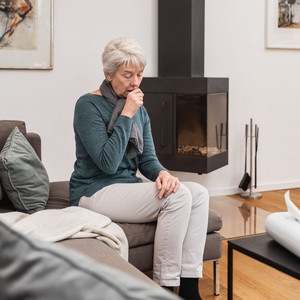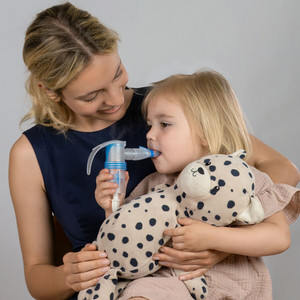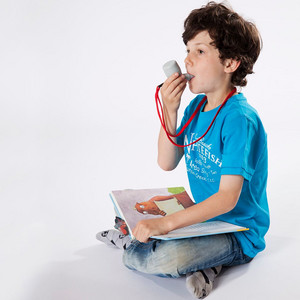
Irritated bronchial tubes and a persistent cough are often an indication of acute bronchitis. Bronchitis is when the bronchial mucous membranes are temporarily inflamed. The constant coughing can not only affect your daily life, but can also lead to microinjuries in the bronchial mucous membranes which can in turn worsen the inflammation. This is why you should act quickly to calm the irritated bronchial tubes.
In this article we explain the causes and give you helpful tips on how to soothe and relax your airways. The most important point first: Go to your doctor if the cough persists for several weeks or is accompanied by fever, pain, coughing up blood or shortness of breath.
Acute bronchitis is usually caused by viruses, such as (in alphabetical order) adenoviruses, coxsackieviruses, coronaviruses, parainfluenza viruses, rhinoviruses or RS viruses (RSV). Viruses damage the cells of the bronchial mucous membrane and impair or destroy the function of the cilia. This triggers an inflammatory reaction in the body, which causes the bronchial mucous membranes to swell.
This is part of the immune response, where blood vessels in the bronchial wall dilate so that blood can more easily reach the mucous membranes and white blood cells can be transported to the site of the infection more swiftly to fight the pathogen. This increased blood supply to the bronchial mucous membranes is one of the reasons they swell up.
As well as this, the mucous membranes produce more mucus in which the dead cells and pathogens are collected. Since the function of the cilia (mucociliary clearance) is destroyed by the infection, the mucus is not properly transported away, but instead collects in the airways. The mucus and swelling irritate the cough receptors in the bronchial tubes, which triggers a constant cough.
This continuous coughing can lead to micro-injuries in the bronchial mucous membranes, which may spur on the inflammatory processes. This is why it is important to calm irritated bronchial tubes, to get the cough under control and at the same time to gently release the mucus from the airways.

You can try the following to calm irritated bronchial tubes:
Moist mucous membranes are intact mucous membranes which means they are better protected against viruses and inflammation than if they were dry. So make sure you drink enough. That keeps the mucous membranes moist from the inside out. They can be moistened from the outside by inhaling with an inhalation device with a nebuliser, such as the PARI BOY – find out more below.
Note: Inhaling steam over a pot is a mistake that has no effect on bronchitis. The droplets are too large to reach the lower airways. They cannot enter the lungs and only get as far as the nose and throat.
When you have bronchitis, your bronchial tubes have already taken a hit. Therefore, you should avoid breathing in substances that could irritate your bronchial tubes even more. Examples of this are:
Ensure that you regularly open the windows or go outside in the fresh air.

Inhalation therapy with saline solution or 3% hypertonic saline solution can help irritated bronchial tubes – especially if you have a buildup of mucus in the airways. Saline solutions moisten the mucous membranes and help liquify the mucus. This makes it easier to transport towards the mouth so that it can be more easily coughed up. Nozzle nebulisers (e.g. PARI BOY), ultrasound nebulisers and vibrating membrane nebulisers (e.g. VELOX) are ideal for inhalation therapy.
And we cannot stress enough: Inhaling salt over a pot of steaming hot water is not possible. Read more about it here: Why steam inhalation does not help against a cough.
There are breathing and coughing techniques you can use to reduce coughing fits or keep them in check and so protect your irritated bronchial tubes. Helpful breathing techniques to control the urge to cough and against coughing fits include pursed lip breathing and breathing through your fist.

If a buildup of thick mucus is irritating your bronchial tubes, there are breathing techniques and aids that can gently transport the secretions out of your airways. The breathing techniques include pursed lip breathing and huffing.
The respiratory therapy equipment PARI O-PEP efficiently loosens bronchial mucus. When you breathe out through the O-PEP, a ball inside the device starts to vibrate. These vibrations spread to the bronchial tubes where the secretions are shaken off the mucous membranes – like shaking ketchup out of a bottle.
If your irritated bronchial tubes leave you short of breath, breathing techniques can again help to soothe them. The respiratory therapist Marlies Ziegler presents breathing exercises against shortness of breath and panic attacks in the blog.

In infants and children, an infection with respiratory syncytial virus (RSV) often leads to bronchitis or bronchiolitis. In this situation, the irritated bronchial tubes can also be calmed with inhalation therapy using a nebuliser. Inhalation therapy with infants can work well with a few tricks. In infants and children, it is especially important to see a doctor without delay to find out what is causing the cough. Other therapeutic measures may be required.
Note: The information in this blog post is not a treatment recommendation. The needs of patients vary greatly from person to person. The treatment approaches presented should be viewed only as examples. PARI recommends that patients always consult with their physician or physiotherapist first.
An article written by the PARI BLOG editorial team.
© 2025 PARI GmbH Spezialisten für effektive Inhalation